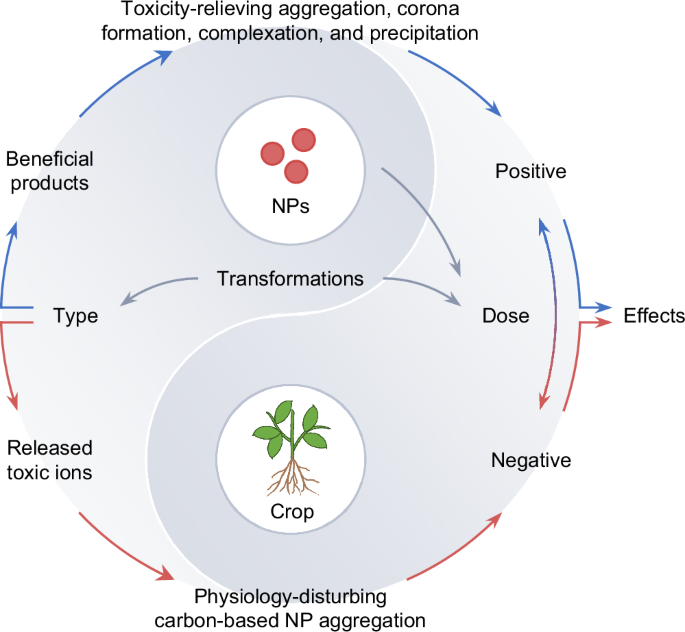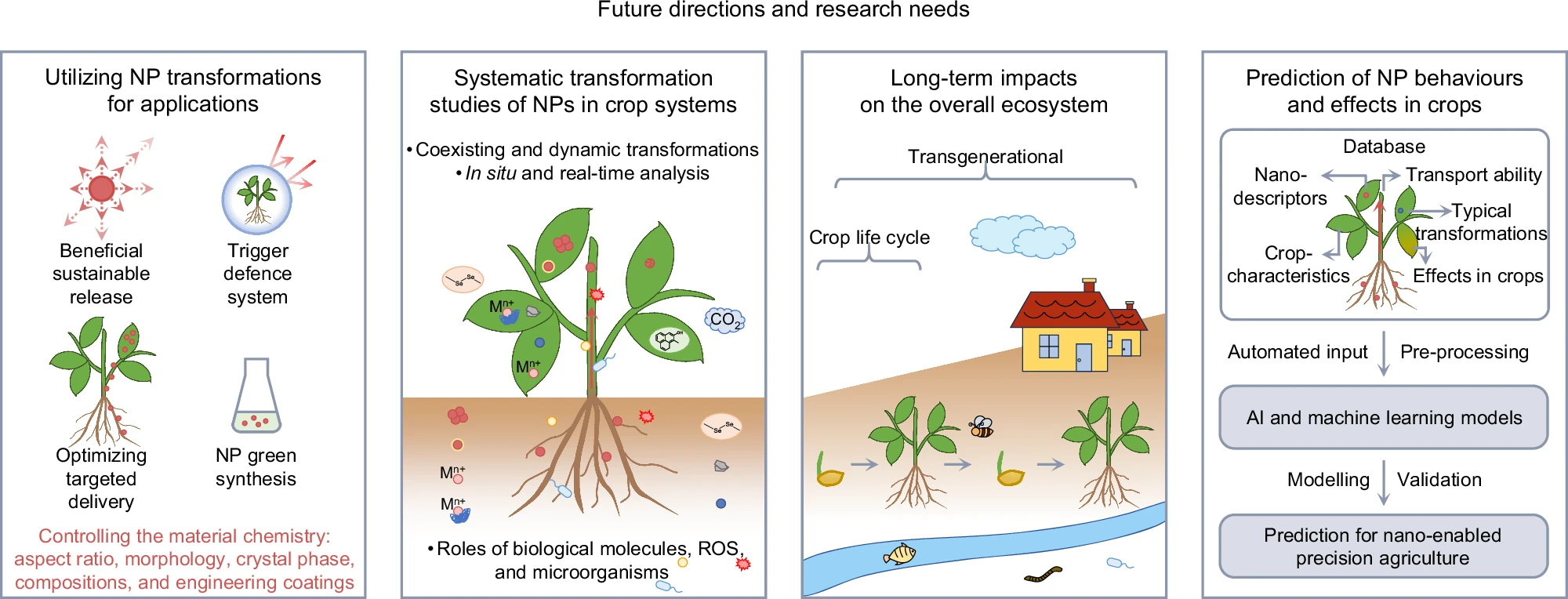It seems that I’m hearing the term “nanotechnology” more frequently these days. As a technology that is driving many breakthroughs in our lives, research is being conducted day and night. So, I decided to read some reviews to see how nanotechnology is being applied in the field of agriculture.

- Introduction of Nanotechnology into Agriculture
- Structure and Properties of Nanoparticles
- Penetration and Mechanism of Action of Nanoparticles in Plants
- Behavior of Nanoparticles: Transformation Processes and Their Impact
- Interaction Between Nanoparticles and the Environment
- Optimization of Nanoparticle Design and Application
- Social and Ethical Aspects of Nano-Agriculture
- Sustainable Agriculture and the Future of Nanotechnology
- Future Prospects for Nanotechnology in Agriculture
Introduction of Nanotechnology into Agriculture
Applying nanotechnology to agriculture opens up new possibilities. Nanoparticles (NPs) have the potential to significantly enhance traditional agricultural techniques due to their high surface area and unique physicochemical properties. In conventional agriculture, the extensive use of fertilizers and pesticides has been common, but these chemicals often leach into the soil and water systems, causing environmental issues. NPs are expected to provide new means to address these problems. For example, due to their high target specificity, NPs can deliver efficient nutrient supply and pest control. Additionally, with innovative ideas, NPs could potentially replace traditional methods more efficiently or even create unexpected new agricultural techniques.
Structure and Properties of Nanoparticles
Nanoparticles (NPs) are extremely small particles that range from 1 nm to 100 nm in size. This tiny size grants NPs certain physical and chemical properties. For instance, the smaller the NPs, the larger the surface area per unit volume. This increases the area of contact with other substances, thereby enhancing the rate of chemical reactions and increasing reactivity. Furthermore, at the nanoscale, different laws from those in our macroscopic world may apply, and these effects in the “quantum mechanics” realm can give NPs unique electrical, optical, and magnetic properties. These properties become powerful tools in the science-heavy field of “agriculture.”
Penetration and Mechanism of Action of Nanoparticles in Plants
What happens when plants encounter NPs? The mechanism of action of nanoparticles (NPs), not just in plants, is complex and involves the interplay of many factors. In plants, NPs are absorbed through leaves, roots, and stems. Once NPs reach the plant cells, they exhibit effects different from those of conventional pesticides and fertilizers due to their unique chemical and physical properties. For example, because NPs are so small, they can pass through cell walls and directly enter the cells. NPs can be made from various materials, but for instance, if NPs are designed to generate reactive oxygen species (ROS), merely spraying them could influence the plant’s physiological processes. If we can control plants by simply spraying them with tiny substances without using chemicals, it could be a revolutionary technique.
Behavior of Nanoparticles: Transformation Processes and Their Impact
Understanding the “behavior” of nanoparticles (NPs) in plants and their surrounding environment is crucial to harnessing “nano-agriculture.” This behavior, or the transformation process, includes various “chemical reactions” such as aggregation, dissolution, ionization, complex formation, precipitation, organic conversion, and redox reactions. Metal-based NPs may “ionize” in the soil or within plants, resulting in the formation of new chemical substances in the plant, which can have either positive or negative impacts on the plant’s growth and development. Silver nanoparticles (AgNPs) are an example of metal-based NPs; they possess antimicrobial properties due to ionization, but they may also negatively affect plant growth. Understanding the impacts of these NP transformation processes is essential for establishing groundbreaking “nano-agriculture.”
Interaction Between Nanoparticles and the Environment
A research area that needs more understanding in the context of nanoparticles (NPs) is their interaction with the “environment.” When NPs are released into the environment, their small size and high reactivity could cause widespread spatial and temporal effects. Depending on the type of NPs, they may affect microbial activity in the soil, altering soil health. If NPs leach into water systems, they could impact water quality and aquatic life. If released into the atmosphere, the effects on the respiratory systems of humans and animals need to be considered. Evaluating and managing these environmental interactions is also essential for safely implementing “nano-agriculture” in society.
Optimization of Nanoparticle Design and Application
Challenges abound in applying nanoparticles (NPs) to agriculture. The next focus is on “design” and “optimization.” NPs can be designed to function for specific purposes, such as promoting nutrient absorption in specific crops or having antimicrobial effects against certain pathogens. Moreover, by adjusting the shape or surface modification of NPs, their effectiveness and safety can be fine-tuned. This could lead to more efficient and sustainable agricultural technologies using NPs. However, just because a desired effect has been achieved does not mean that the NPs are “optimized.” Their effectiveness may vary depending on the location and timing of use. It is crucial to continually verify and optimize the NPs themselves, or their application methods (such as spraying or coating).
Social and Ethical Aspects of Nano-Agriculture
The introduction of nano-agricultural technologies requires consideration of social and ethical issues. First, there is a debate on how the use of NPs should be regulated. Since NPs are a new technology, their long-term effects are not yet fully understood. Therefore, proper regulation and monitoring are required. Additionally, it is important to consider how nano-agricultural technology will be accepted by agricultural workers and consumers. “Don’t use it because you don’t understand it” does not allow new technologies to develop. Consumers, in particular, may have concerns about agricultural products containing nanoparticles, similar to reactions to genetically modified organisms (GMOs). It is essential to bridge the gap between users and consumers through transparent information dissemination.
Sustainable Agriculture and the Future of Nanotechnology
“Sustainability” is not just a buzzword for increasing productivity, but a key concept in future agriculture. Nanotechnology may offer good solutions for achieving sustainable agriculture. Addressing population growth and climate change requires new approaches that go beyond traditional agricultural techniques. As explained above, nano-agricultural technology has the potential to increase crop yields, reduce environmental impacts, and promote efficient resource use. However, if increased efficiency leads to land that cannot sustain future crops, the overall impact is negative. We need to improve efficiency while also ensuring sustainability. This is indeed a demanding requirement, and it may be difficult to meet this demand with existing technologies. One of the possible solutions from a different dimension, literally applying different rules (such as those of quantum theory), is nanotechnology.
Future Prospects for Nanotechnology in Agriculture
Nanotechnology is expected to bring new possibilities to agriculture, but there are still many challenges to its widespread adoption. Approaches that consider not only technical aspects but also societal acceptance and environmental impact are necessary. With further research and technological development, nano-agricultural technology is expected to play a significant role in achieving sustainable agriculture. It is also important to establish new regulations and guidelines to ensure the safety and effectiveness of nanoparticles. This will make nano-agricultural technology a trusted technology for non-agriculturalists as well, leading to its widespread adoption.
Conclusion: Nanotechnology may create a new form of agriculture!



コメント